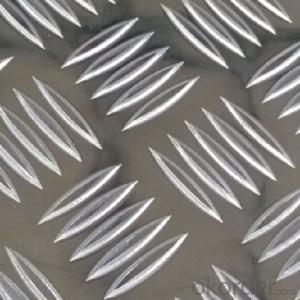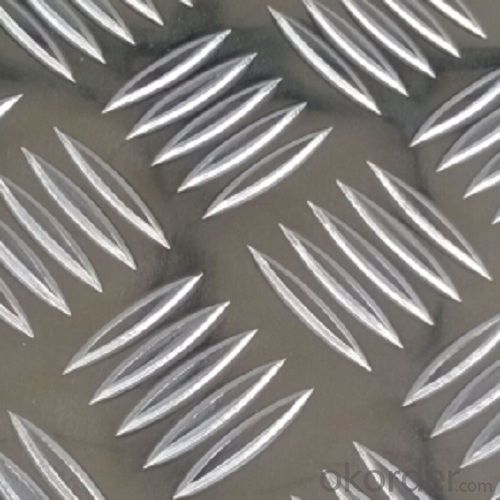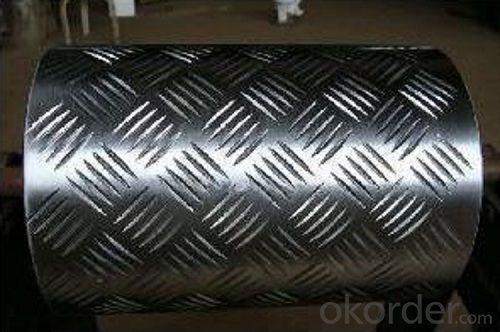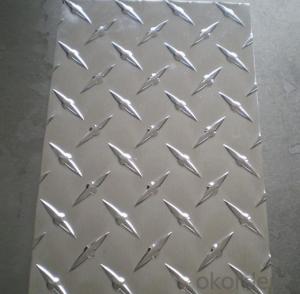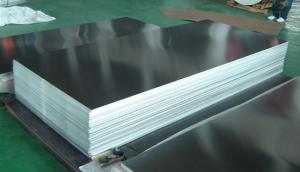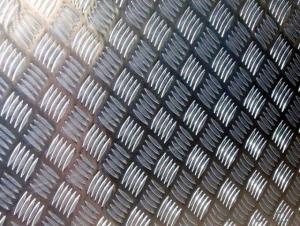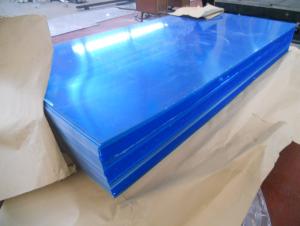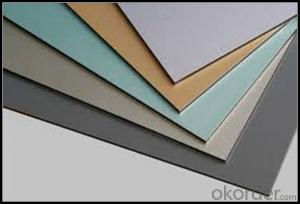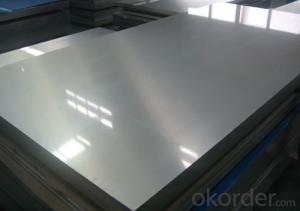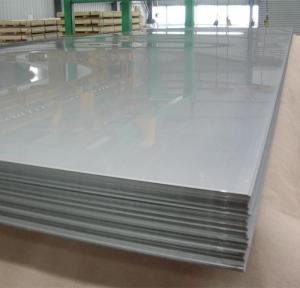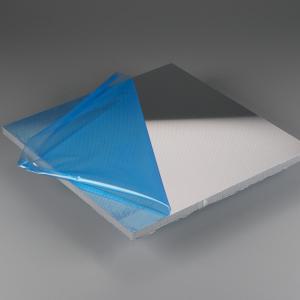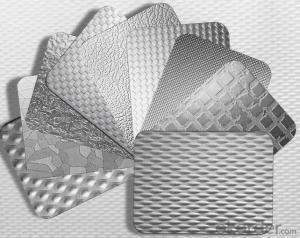Smooth Aluminum Siding Sheets with Various Patterns Tread/Checker Plate
- Loading Port:
- Shanghai
- Payment Terms:
- TT OR LC
- Min Order Qty:
- 2.5
- Supply Capability:
- 5000 m.t./month
OKorder Service Pledge
OKorder Financial Service
You Might Also Like
l Production Introduction
1. Commodity: Factory manufacture low price high quality aluminum dimond plate sheets
2. Alloy No.: 050 1060 1100 3003 3004 3104 3005 3105 5005 5052 8011
3. Size: Thickness: 0.15-5.00mm(Tolorance±0.02mm)
Width:200-1600mm(Tolorance±1mm)
Length: 500-1500mm(Tolorance±1mm)
4. Application:
1) air plane, refrigerators ,audio equipment
2) building materials: ceilings, walls
3) telephones, digital cameras
4) plastic composite board, aluminum and plastic pipe
5.Month Capacity: 5000MT/Month
6.Pattern: 2 bars, 3 bars, 5 bars, diamond bar
l Packaging & Delivery
Packaging detail: First, plastic cloth; Second, Pearl Wool ; Third, wooden cases with dry agent ,without fumigation, wooden pallets
Delivery detail: Within 25days
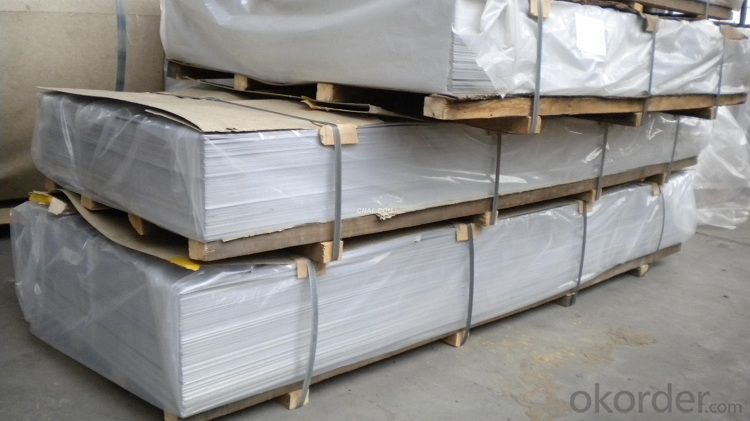
l CNBM Images
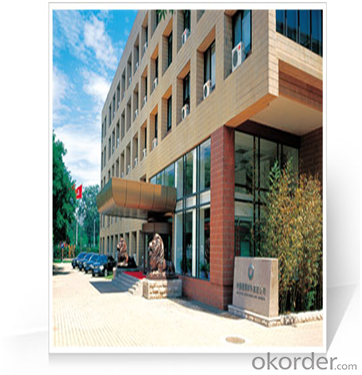

l Product Images and Application
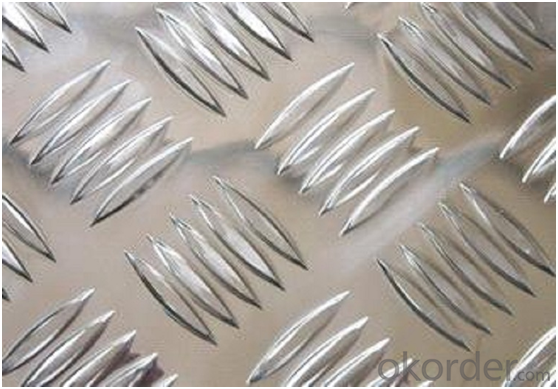
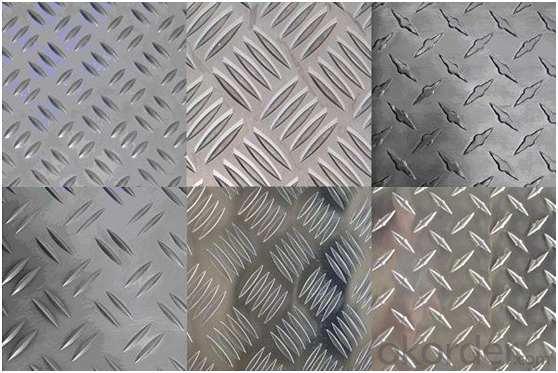
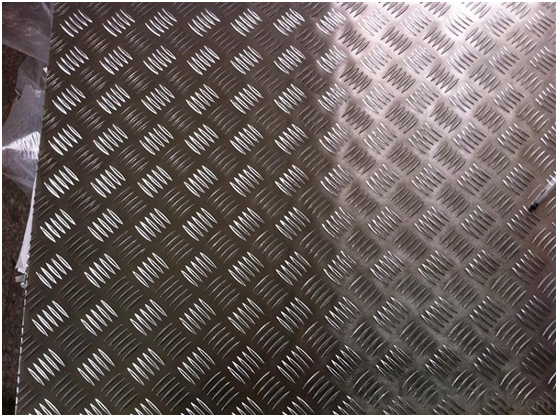

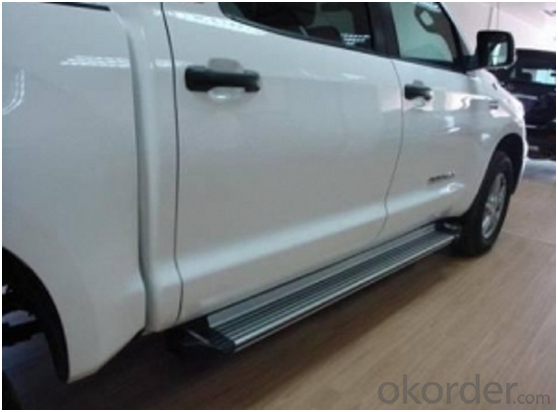
l FAQ
Q: Do you provide free samples?
A: Yes, free samples will be sent to you on freight at destination.
Q: Can I get your latest products catalogue?
A: Yes, it will be sent to you in no time.
Q: What is the MOQ?
A: 2.5 tons
Q: What are your payment terms?
A: We accept L/C, T/T.
- Q: Are 101 aluminum sheets suitable for aircraft manufacturing?
- Yes, 101 aluminum sheets are suitable for aircraft manufacturing.
- Q: What are the advantages of using aluminum sheet in construction?
- There are several advantages to using aluminum sheet in construction. Firstly, aluminum is a lightweight material, making it easier to handle and transport on construction sites. This reduces the need for heavy machinery and equipment, resulting in cost savings and improved efficiency. Secondly, aluminum has excellent corrosion resistance properties. Unlike other metals, such as steel, aluminum does not rust or corrode when exposed to moisture or harsh weather conditions. This makes it highly durable and suitable for outdoor applications, such as roofing or cladding. Additionally, aluminum is a highly versatile material that can be easily shaped and formed into different sizes and profiles. This allows for greater design flexibility, enabling architects and engineers to create innovative and unique structures. Moreover, aluminum is a sustainable material. It is 100% recyclable, meaning that it can be reused indefinitely without any loss in quality or performance. This makes it an environmentally friendly choice for construction projects, as it helps reduce waste and minimize the carbon footprint. Furthermore, aluminum has excellent thermal and electrical conductivity properties. It reflects heat and light, helping to maintain comfortable indoor temperatures and reduce energy consumption. It is also an excellent conductor of electricity, making it ideal for electrical wiring and components in buildings. Lastly, aluminum is a cost-effective material in the long run. Although it may have a higher initial cost compared to other building materials, its low maintenance requirements and long lifespan offset these costs over time. It does not require painting or regular upkeep, saving both time and money in the maintenance and repair of structures. In conclusion, the advantages of using aluminum sheet in construction include its lightweight nature, corrosion resistance, versatility, sustainability, thermal and electrical conductivity, and cost-effectiveness. These qualities make it a highly desirable material for a wide range of construction applications.
- Q: This question asks if aluminum sheets can be recycled repeatedly without losing their quality.
- <p>Yes, aluminum sheets can be recycled multiple times without losing their quality. Aluminum is a highly recyclable material, and the recycling process does not degrade the material's properties. In fact, recycled aluminum requires significantly less energy to produce compared to mining and refining new aluminum from bauxite ore. This makes aluminum recycling an environmentally friendly and cost-effective process, contributing to sustainability and reducing the demand for raw materials.</p>
- Q: What are the different fabrication methods used for aluminum sheets?
- Aluminum sheets undergo various fabrication methods, each presenting its own advantages and applications. Rolling, extrusion, casting, and stamping are among the most commonly employed techniques. Rolling, the most prevalent method, entails passing the aluminum through a series of rollers to reduce thickness and form a flat sheet. This approach allows for precise control over sheet thickness and shape, rendering it suitable for an array of applications, from packaging to building materials. Another well-received method is extrusion, where heated aluminum is pushed through a die to create a specific shape or profile. This technique is commonly employed to manufacture intricate shapes like tubes, rods, and channels. Extruded aluminum sheets exhibit high strength and durability, making them appropriate for structural applications in construction and automotive industries. Casting involves pouring molten aluminum into a mold, allowing it to solidify. This method is frequently used for producing intricate shapes that are challenging to achieve through other means. Cast aluminum sheets can boast unique textures and designs, making them popular for decorative purposes. Stamping utilizes a press to shape the aluminum sheet by exerting pressure and forming it into the desired shape. This technique is commonly utilized for creating precise, small parts such as brackets, connectors, and electrical components. Stamped aluminum sheets offer exceptional dimensional accuracy and can be produced in large quantities at a relatively low cost. Additionally, other fabrication techniques such as welding, bending, and laser cutting can be employed to further process aluminum sheets and craft custom shapes and designs. In conclusion, the choice of fabrication method for aluminum sheets relies on the desired application, required properties, and complexity of the desired shape. Each method possesses unique advantages and capabilities, enabling a broad range of possibilities in aluminum sheet fabrication.
- Q: What are the different methods of surface cleaning for aluminum sheets?
- Aluminum sheets can be cleaned using various methods, each with its own advantages and suitability for different cleaning needs. One method is mechanical cleaning, which involves using techniques like brushes, abrasive pads, sandpaper, or a wire brush to remove dirt, stains, and oxidation from the surface. However, caution must be taken to avoid scratching the surface. Chemical cleaning, on the other hand, utilizes specific cleaning agents or solutions designed to dissolve or remove dirt, grease, oil, or other contaminants from aluminum surfaces. The choice of cleaning agent depends on the type of dirt or stain to be removed. High-pressure water cleaning is a method that employs a strong water jet to dislodge dirt or grime from the aluminum surface. It works well for removing loose debris or light dirt from larger areas, but may not be effective for heavily soiled surfaces. Steam cleaning involves using high-temperature steam to loosen dirt, grime, or other contaminants, making them easier to wipe or rinse away. It is versatile and suitable for both small and large surfaces. Another specialized method is electrolytic cleaning, which uses an electric current to remove contaminants. The aluminum sheet is immersed in a cleaning solution, and the electric current attracts the contaminants to a sacrificial electrode, leaving the sheet clean. However, this method requires specialized equipment and expertise. When choosing the appropriate cleaning method, it is important to consider the specific requirements, condition of the sheet, and desired level of cleanliness. Testing the chosen method on a small, inconspicuous area is also advisable to avoid potential damage.
- Q: i want to build a smelter to recycle aluminum auto parts
- It requires high temperature (933K), and is inefficient for small quantities. Why not just sell it to your local recycler?
- Q: doesn't particularly need to be welding but i need to make an air tight permanent seal around 2 very thin sheets of aluminium (like .02 inches thick) i was thinking .02 inch 5052 aluminum because its the thinnest i can find but am obviously up for suggestions.
- GOOP silicone adhesives are much harder when set than 100% silicone adhesives more commonly seen, but if you are just butting the tubes, epoxy to build a gusset would be a better choice. Always clean all surfaces with soap and water and then with denatured or high percent rubbing (isopropal) alcohol to improve bonding.
- Q: How do you prevent oil or grease stains on aluminum sheets?
- To avoid oil or grease stains on aluminum sheets, there are several steps you can take: 1. Make it a habit to regularly clean the aluminum sheets. This will help eliminate any existing stains and prevent them from building up. Use a mild detergent or a mixture of water and vinegar to clean the sheets. Avoid using harsh cleaners or abrasive pads as they may harm the surface. 2. Apply a protective coating to create a barrier between the aluminum surface and oil or grease. Clear lacquer or anodizing are examples of coating options available. These coatings create a smooth and impermeable surface, making it difficult for oil or grease to penetrate and stain the aluminum sheets. 3. Use a barrier material if you frequently work with oil or grease near aluminum sheets. Consider using a silicone mat or placing parchment paper or aluminum foil between the aluminum sheet and the source of oil or grease to prevent direct contact. 4. Proper storage is crucial for preventing oil or grease stains on aluminum sheets. Store them in a clean and dry environment, away from potential sources of contamination. Keep the sheets covered or wrapped in a protective material to prevent dust, dirt, or oil from settling on the surface. 5. Handle aluminum sheets with clean hands. Ensure your hands are free of oil or grease before touching the sheets. Even small amounts of oil or grease on your hands can transfer onto the sheets and cause stains. If necessary, wear clean gloves or use clean tools when working with aluminum sheets to minimize the risk of stains. By implementing these preventive measures, you can significantly reduce the likelihood of oil or grease stains on your aluminum sheets, keeping them clean and in excellent condition.
- Q: Are the aluminum sheets suitable for manufacturing kitchen backsplashes?
- Yes, aluminum sheets are suitable for manufacturing kitchen backsplashes. Aluminum is a lightweight and durable material that is resistant to corrosion and heat. It is also easy to clean and maintain, making it ideal for use in kitchens where splatters and spills are common. Aluminum sheets can be easily cut and shaped to fit any kitchen size and design, allowing for flexibility in creating a customized backsplash. Additionally, aluminum offers a sleek and modern aesthetic, adding a contemporary touch to the kitchen décor. Overall, aluminum sheets are a practical and stylish choice for manufacturing kitchen backsplashes.
- Q: How do I calculate the weight of aluminum sheet? What is the density?
- First calculate the density of each aluminum plate, then calculate the volume, then the density is good, the volume is the weight
Send your message to us
Smooth Aluminum Siding Sheets with Various Patterns Tread/Checker Plate
- Loading Port:
- Shanghai
- Payment Terms:
- TT OR LC
- Min Order Qty:
- 2.5
- Supply Capability:
- 5000 m.t./month
OKorder Service Pledge
OKorder Financial Service
Similar products
Hot products
Hot Searches
Related keywords
